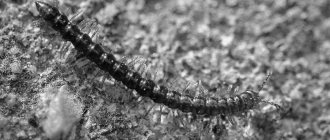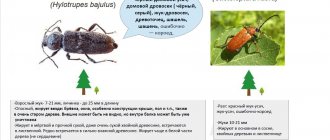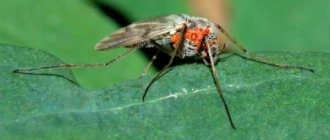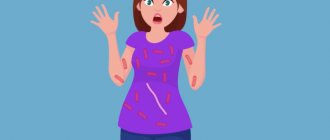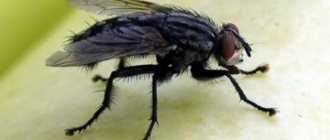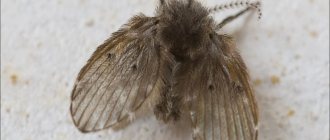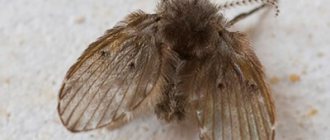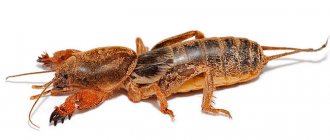Insects are the largest class of invertebrate animals on the planet, with more than a million species. Of course, without them, life on Earth is impossible, but a huge number of insects lead a parasitic lifestyle, with which humanity has been at war since time immemorial.
There are also insects that are safe for us, but dangerous for animals, but mostly parasites are not selective.
What to do in such a situation? To get started, we recommend reading this article. This article describes in detail methods of controlling parasites. We also recommend that you consult a specialist. Read the article >>>
Types of insect parasites
Parasites differ from symbioses by the complete opposite - they simply kill the host organism that gives them life. Why nature arranges it this way is not clear, apparently population regulation.
Parasites worsen the overall well-being of the animal and can also transmit an infectious disease.
Conventionally, they can be divided into 2 types – endoparasites and ectoparasites. The former live inside the body (worms, larvae), developing until the end of a certain cycle, the latter only damage the skin surface (blood-sucking). Ectoparasites are in a sense more pleasant - they drank blood and flew away (as a rule, these are female individuals, and blood is not necessary for them, but for their offspring), but endoparasites can live for a month or two both under the skin of the animal and in the internal organs , like the stomach and large intestine. Gadfly larvae even prefer to spend the entire winter under the host's skin.
Ophion luteus
Red mites
Red mites have a plump, furry, cushion-like body and an eye-catching red coloration. As you might guess, with such a charming appearance, these mites have a rather disgusting taste.
Although these mites become active predators as adults, their larvae quietly parasitize other insects. Red mite larvae have many hosts, but, for example, in India they try to stick to crickets.
Extracts from ticks are used in Eastern medicine to treat male infertility and paralysis. Scientific studies have shown that various body parts of red mites have antifungal and antibacterial properties. Red mite larva parasitizing a moth.
Flea Squad
Insects of this order have a body flattened on the sides with numerous outgrowths of the chitinous shell in the form of bristles and denticles, which serve for fixation on the host’s hair. There are no wings; to move, fleas use complexly arranged limbs in the form of a jumping apparatus. The piercing-sucking type of mouthparts is used to feed on the blood of warm-blooded animals, including humans.
Representatives of this species that parasitize humans are human and rat fleas. They are parasitic on human skin and feed on his blood, and also carry the following vector-borne diseases: plague, tularemia, rat typhus. They can also cause human infection with rat and dog tapeworms.
The tropical sand flea is about 1 mm in size and yellowish-gray in color. Found in the grass and sand of the American and African continents, it attacks humans and burrows into the skin between the toes, causing sarcopsillosis . This disease can later cause tetanus and gangrene.
Tropical sand flea
Control methods include keeping the premises clean, wet cleaning and rodent control. The use of insecticides and repellents is effective. In tropical countries, walking barefoot is not recommended.
Parasitic insects: rider wasp
Parasitic insects of the family Ichneumonidae
got their name because of their resemblance to the mystical creature ichneumon, which was supposedly the sworn enemy of dragons.
Wasp of the family Ichneumonidae
"Ichnemon"
translated from Greek means
a hunter tracking down wild animals
.
This name is most suitable for a wasp from another family - Braconidae
. Interestingly, a wasp can be trained to detect many subtle odors, such as the smell of explosives or drugs. Surprisingly, these creatures learn much faster and easier than bloodhounds!
A caterpillar with wasp larvae parasitizing on it
Moreover, these parasitic wasps are not capable of stinging a person, and also require a very simple diet - sweet water.
The process of laying eggs in the bodies of other insects
Ants are parasites
There are certain types of ants that are social parasites. They destroy the nests of carpenter ants
, and the surviving worker ants are turned into their slaves.
After the mating flight, the queens of these ants may end up in the nest of carpenter ants and drive out the queen living there.
These ants, which are called "medicine ants"
, have been used in China and Taiwan as ingredients for medicines for thousands of years. Research shows that extracts from the body of ants have strong analgesic and anti-inflammatory effects.
Cochineal mealybug
- an insect that lives on
prickly pear cacti
. The peculiarity of this insect is that it is processed to produce cochineal dye.
Exports of cochineal were second only to silver in the Spanish colonies of the New World. Spain went through a serious financial crisis when synthetic dyes were invented, because most of the cochineal production enterprises went bankrupt.
Today, the production of natural dyes is being revived, and there is renewed interest in cochineal, as it is an excellent natural substitute for food dyes based on coal or gasoline byproducts.
Troop Lice
Lice include head and body louse, which can interbreed and produce offspring.
Head lice are highly sexually dimorphic . Males up to 3 mm with a rounded rear end are smaller than females, in which it is forked. The mouthparts are of the piercing-sucking type. Clothes are larger in size.
Head louse
Lice are ectoparasites that cause pediculosis . Their saliva also causes itching and burning, resulting in the formation of a gateway for secondary infection. In addition, lice are carriers of relapsing and typhus.
The pubic louse has a short, trapezoidal body up to 1.5 mm long. Causes phthisis, characterized by itching and blue spots at sucking sites.
Pubic louse
Bedbugs are harmful blood suckers
Bed bugs belong to the group of blood suckers and can cause significant harm to humans. The insect is easy to recognize by its characteristic features:
- body length ranges from 4 to 8 mm;
- shell color – light yellow or dark brown;
- active after dark;
- the only food product is blood.
Parasites live on average up to one year. You can easily find them in old pillows, mattresses, as well as between floorboards, under linoleum, wallpaper or baseboards. Bedbugs leave bites on the human body. In general, they are not dangerous, but can cause allergic reactions.
Bed bug
Domestic bloodsuckers - mosquitoes
Having a clear understanding of what kind of domestic insects exist in the apartment (the photos and names below will simplify the task of recognition), you can quickly find your bearings when meeting with representatives of different groups to develop a plan to combat and prevent their appearance.
The mosquito, for example, also belongs to the group of blood-sucking mosquitoes and is found in almost everyone’s home with the onset of warm days. The insect has a body length of up to 7 mm, most often distinguished by a yellow color.
Female mosquitoes drink human blood and also do not disdain plant juice; males feed exclusively on plant juice.
The average female mosquito lives on average from 43 to 57 days. Life expectancy is affected by temperature and humidity, but most of all by the availability of power sources. The male lives no more than 19 days.
Considering that female mosquitoes feed on human blood, they can be considered pests. Insects can cause infection with malaria, meningitis, yellow fever and other diseases.
Insect pests
Woodworms are furniture pests that lay eggs in recesses and small cracks. In three years, the larva grows into an adult. They make passages in the wood where they live.
Most often, only the secondary signs of this insect's presence are noticeable - small holes, mounds of sawdust, damaged wooden furniture.
Human life is connected with living nature, and insects are part of it. This neighborhood has been going on since time immemorial. People have even managed to domesticate some insects. For ants, there are special farms for raising them in apartments - formicariums.
ladybugs
The most common insect predators.
Here is a photo of a ladybug larva.
They look like microscopic crocodiles. Their color is remarkable: bright red or yellow spots on a dark background.
Unfortunately, many people confuse the eggs and larvae of the ladybug with the eggs and larvae of the Colorado potato beetle and mercilessly destroy them. But the larvae of the Coloradoan are almost perfectly round and pinkish. And the eggs of the pest are bright orange, while those of the ladybug are bright yellow. She lays them vertically to the surface of the leaf and is always close to aphid colonies.
By destroying the clutches and larvae of ladybugs, gardeners deprive themselves of excellent assistants in the fight against pests.
During the larval phase, each ladybug eats about 1,200 aphids! An adult ladybug eats about 40 aphids per day.
Cockroaches are the most frequent “guests” in the house
Analyzing which insects at home can disturb peace and comfort, it is difficult to forget about cockroaches. Everyone has encountered their neighborhood at least once in their life. Insects belong to the category of harmful domestic insects, which, like the previous representatives of this group, lead an active nocturnal lifestyle. The body size of the cockroach does not exceed 9.5 cm. The color is predominantly yellow-brown or dark.
Pests choose all kinds of food scraps as a source of food and do not disdain feces. An adult lives for about 30 weeks in secluded places, out of sight of humans. Most often these are holes between the floor and the baseboard, cabinets and chests, old suitcases, etc.
Pests cause damage to indoor plants, furniture, food, are capable of spreading dangerous infections and cause the development of helminths.
Order Cockroaches
Representatives are large insects up to 3 centimeters long with a dorsoventrally flattened body with characteristic sexual dimorphism. The mouthparts are gnawing. They exist in large groups, due to the presence of specific skin glands that synthesize an odorous secretion that attracts other individuals.
The main representatives: black, red and American cockroaches.
From a medical point of view, they are carriers of various infectious diseases, as well as helminth eggs and protist cysts. The second characteristic danger is their ability to attack sleeping infants and gnaw off the delicate skin of the nasolabial triangle, while introducing a secondary infection into the damaged areas of the epidermis.
To kill cockroaches, insecticides and baits containing borax are used. Methods are used to prevent their re-introduction into the home: removing leftover food at night, regular cleaning, sealing cracks on the floor.
Types and feeding habits of moths
Domestic butterflies reveal themselves immediately when they appear. They circle in different rooms, depending on where the offspring are laid. There are several types of moths:
- wardrobe (lives in closets);
- fur coat (feeds on natural fibers of fur clothing);
- furniture (occupies furniture upholstery);
- food (spoils groceries).
The adult individual looks inconspicuous. Its color varies depending on the species (milky, brown, gray), and its size is small. Butterflies are characterized by the absence of a digestive system (it is underdeveloped), which does not allow them to feed, which means that only pest larvae spoil food and things. These are light-colored caterpillars that develop in the same place where they feed. They form a little cover around themselves; when moving, it moves along with the caterpillar.
The main function of adults is reproduction. The moth lays eggs and then dies. The larvae appear after 2 weeks and begin to actively destroy furniture and food. However, this does not mean that there is no need to breed adults. On the contrary, the sooner they disappear, the fewer larvae will appear in the future. Moths that live in food are more difficult to control, since this eliminates the possibility of using chemical insecticides. You can only process the cabinets.
It is possible to defeat parasites!
Antiparasitic Complex® - Reliable and safe removal of parasites in 21 days!
- The composition includes only natural ingredients;
- Does not cause side effects;
- Absolutely safe;
- Protects the liver, heart, lungs, stomach, skin from parasites;
- Removes waste products of parasites from the body.
- Effectively destroys most types of helminths in 21 days.
There is now a preferential program for free packaging. Read expert opinion.
Read further:
Domestic insect parasites: photos and names, control methods
No to ticks: where to order insect repellent treatment?
What do mosquitoes eat, besides blood, females and males, in the swamp and in nature?
Coliform bacteria in food: what they are and the reasons for their appearance
Centipede mosquito. Description, stages of development. What do big mosquitoes eat? Whether they bite or not. Damage from long-legged mosquitoes
Types of worms in cats: photo, description, name and methods of control and treatment
Tatarstan experience
Specialists of the branch in the Republic of Tatarstan use entomophages using a quadcopter
The experience of using entomophages in the Republic of Tatarstan is quite extensive. Trichogramma was applied manually, mechanized using a universal trichogramma spreader (URT), using a hang glider.
Since 2022, specialists from the branch of the Federal State Budgetary Institution "Rosselkhoztsentr" in the Republic of Tatarstan began releasing trichogramma into the fields using "drones" - quadcopters.
This year, such work was carried out on an area of more than 1 thousand hectares on mustard, chickpea, and pea crops at Semena LLC in the Samara Region and at AF Zai LLC in the Zainsky District of the Republic of Tatarstan on spring rape crops against cabbage moths.
The introduction of Trichogramma using unmanned aerial vehicles has a number of advantages, since Trichogramma is a natural regulator of pest numbers, its use is safe and environmentally friendly.
Another advantage is the uniform distribution density of entomophages on crops and the high accuracy of their application. When using a “drone”, its route is specified in detail and has no deviations, which makes it possible to effectively process crops with high productivity. The dispenser built into the quadcopter regulates the supply of biomaterial, which allows you to control the speed, density of its distribution, and processing accuracy.
In addition, on an area of 200 hectares, the lacewing was released on pea crops at Semena LLC, Samara Region, against pea aphids.
The result of introducing entomophages using a quadrocopter greatly pleased the General Director of Semena LLC, Samara Region, V.G. Fokin. Since this farm has not used chemicals on agricultural crops for many years, entomophages are irreplaceable and effective regulators of pest numbers.
Vasily Gennadievich noted that the use of a quadcopter allows entomophages to be introduced evenly over large areas at significant speed in a short time.
Source
#plants #plant protection #biological protection products #insects #entomophages #pests
